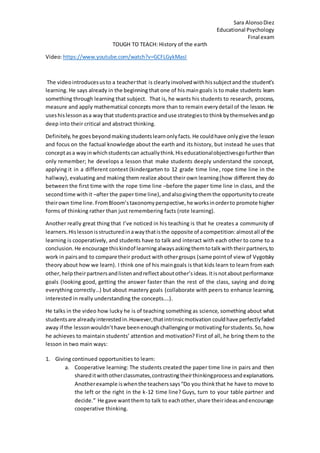
Educational Psychology: Video Analysis
- 1. Sara AlonsoDiez Educational Psychology Final exam TOUGH TO TEACH: History of the earth Video:https://www.youtube.com/watch?v=GCFLGykMasI The videointroducesusto a teacherthat is clearlyinvolvedwithhissubjectandthe student’s learning. He says already in the beginning that one of his maingoals is to make students learn something through learning that subject. That is, he wants his students to research, process, measure and apply mathematical concepts more than to remain everydetail of the lesson. He useshislesson asa waythat studentspractice anduse strategiesto thinkbythemselvesand go deep into their critical and abstract thinking. Definitely,he goesbeyondmakingstudentslearnonlyfacts.He couldhave onlygive the lesson and focus on the factual knowledge about the earth and its history, but instead he uses that conceptasa wayinwhichstudentscan actuallythink.Hiseducationalobjectivesgofurtherthan only remember; he develops a lesson that make students deeply understand the concept, applying it in a different context (kindergarten to 12 grade time line, rope time line in the hallway), evaluating and making them realize about their own learning(how different they do between the first time with the rope time line –before the paper time line in class, and the secondtime withit –after the paper time line),andalsogivingthemthe opportunitytocreate theirown time line.FromBloom’staxonomyperspective,he worksinorderto promote higher forms of thinking rather than just remembering facts (rote learning). Another really great thing that I’ve noticed in his teaching is that he creates a community of learners. Hislessonisstructuredinawaythatisthe opposite of acompetition:almostall of the learning is cooperatively, and students have to talk and interact with each other to come to a conclusion.He encourage thiskindof learningalwaysaskingthemtotalkwiththeirpartners,to work in pairsand to compare their product with othergroups (same pointof view of Vygotsky theory about how we learn). I think one of his maingoals is that kids learn to learn from each other,helptheirpartnersandlistenandreflectaboutother’sideas.Itisnotaboutperformance goals (looking good, getting the answer faster than the rest of the class, saying and doing everything correctly…) but about mastery goals (collaborate with peers to enhance learning, interested in really understanding the concepts….). He talks in the video how lucky he is of teaching something as science, something about what studentsare alreadyinterestedin.However,thatintrinsicmotivation couldhave perfectlyfaded away if the lessonwouldn’thave beenenoughchallengingormotivatingforstudents.So,how he achieves to maintain students’ attention and motivation? First of all, he bring them to the lesson in two main ways: 1. Giving continued opportunities to learn: a. Cooperative learning: The students created the paper time line in pairs and then shareditwithotherclassmates,contrastingtheirthinkingprocessandexplanations. Anotherexample iswhenthe teacherssays“Do you thinkthat he have to move to the left or the right in the k-12 time line? Guys, turn to your table partner and decide.” He gave wantthemto talk to eachother,share theirideasandencourage cooperative thinking.
- 2. Sara AlonsoDiez Educational Psychology Final exam b. Opportunities toparticipate:“Choosewhereyouthinkyouare inthe k-12time line”, “Point out in what part of the rope do you think the Neolithic was”, “Raise your hands if you think differently”, etc. He makes many questions throughout the explanations and during the activities,not only giving the chance to everyone one to participate but also maintaining students engaged to the explanation. c. Student’s active role in discovering the answer by themselves using different resources (textbooks, computers…). The teacher gives students time to research and discoverthe answers. It’sreallyinterestinghow studentsare sointothe lesson that theydon’t stopwhentheyfindthe answerstothe teacher’squestions,butgo furtherin theirowninvestigation.Forexample,whentheyhave tosituatedevents in the rope time line theycome up withnew eventsthattheydiscoverduringtheir research. d. Differentwaystoapproachthe content:He gave the studentsa12-pagesdocument about geologic time scale and history of the earth so they could approach the conceptbefore classandhave backgroundknowledge aboutit.Bydoingthishe was able to invest the time of the lesson in the experience and hands-on activities. Studentshadthe chance to approach the content by reading,experiencing,solving problems,inbiggroup,individually,cooperatively,etc. He says:“Do the same thing multiple times in different ways; sometimes researching, sometimes outside, sometimes with the textbook. That’s the way they are going to learn.” 2. Pressing their thinking: a. Appropriate activitiestomake studentsfeelchallengedandmotivated.Thereisone time that he asks “Where would you place the appearance of oxygen?” and a student says “That’s hard”, and he responds saying “Yes, it’s a challenging one!” That is just an example of how he stablish the lesson, activities and questions so they fit into the students’ motivational zone of proximal development. In this example we can actually see how students, feeling appropriatelychallenged and motivated, run to the part of the rope time line trying to answer to answer the question. Furthermore,he mediatesduring activitiessotheyare reallymeaningful and valuable for students. b. Questions that encourage students thinking and promote deeply understanding. What I’ve notices about thislesson is that is not mainlythe questions what makes studentsthinkandreasonbut the activitiesthemselves. Theyare plannedina way that make students little by little get a deeply understanding of the concept. For example,referringtothe rope time line he says:“Bysettingupa time line like that, where I can have them actively moving back and forward to where they think certainlythingshappened,(…) theynaturallyrealizedandunderstandthe sequence of events. That’s the reason I wanted to teach that way.” Anyway, he also make some high level questions that require more thinking and knowledge connections of students like “Why do you think the book focus only on this part of the earth history time line?”
- 3. Sara AlonsoDiez Educational Psychology Final exam He isreallyinvolvedinmakingthe lessoninterestingandfun. He givesgreatimportance tostep into the shoes of his students and understand how can he planned the lesson to make it attractive.Althoughhismainresource to achieve thisare his activities, duringitsdevelopment he supporthisstudentsandencourage them, boostingtheirmotivation.Forexample,he saysa couple of times “You guys are so good”, and when they don’t get the right answer, instead of saying “wrong” or “you are not paying enough attention, he says “very close!” He presents several characteristics of an authoritative teacher, like his tendency of giving students opportunitiestoparticipate,encourage situationstothink(mainlythroughactivitiesthatimply cooperative learning), and present the content from a valuable perspective, trying to give it a sense. He knows that for many students the big texts in books about earth history are meaningless,sohe turns them into real experiences with much more (and deeply) meaning.
